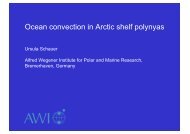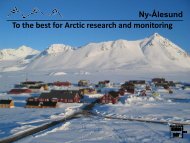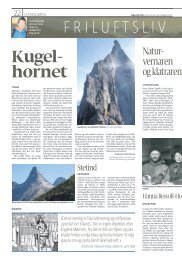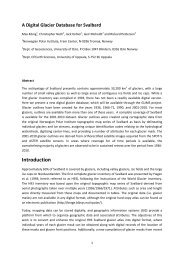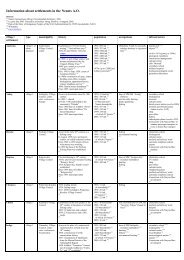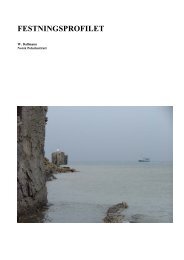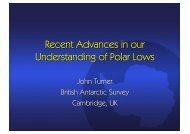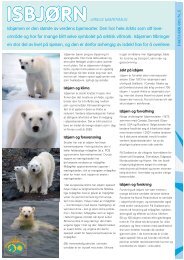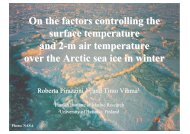Fourth EGU Alexander von Humboldt International Conference
Fourth EGU Alexander von Humboldt International Conference
Fourth EGU Alexander von Humboldt International Conference
Create successful ePaper yourself
Turn your PDF publications into a flip-book with our unique Google optimized e-Paper software.
First Circular<br />
September 2007<br />
European Geosciences Union<br />
<strong>Fourth</strong> <strong>EGU</strong> <strong>Alexander</strong> <strong>von</strong> <strong>Humboldt</strong> <strong>International</strong> <strong>Conference</strong><br />
The Andes: Challenge for Geosciences<br />
Santiago de Chile<br />
November 24-28, 2008<br />
Scope<br />
The Andes, one of the major mountain ranges on Earth, constitute a unique Geosciences<br />
laboratory hosting natural phenomena and processes on virtually all geosciences sub-disciplines<br />
(Solid-earth geophysics, tectonics, volcanology, economic geology, geomorphology, soil<br />
sciences, meteorology/climatology, hydrology, glaciology and geobotany). Moreover, there are<br />
not only many scientific issues specific to each sub-discipline, but also several cross-cutting<br />
themes of tremendous scientific interest and practical relevance, such as the climategeomorphology<br />
interactions over different timescales.<br />
Extending from the northern tropics of Venezuela (about 10°N) all the way to Tierra del Fuego<br />
(about 53°S), with heights ranging over 5000 m at tropical/subtropical latitudes, the Andes<br />
provide a formidable barrier for the tropospheric flow. The Andes not only act as a “climatic wall”,<br />
with dry conditions to the west and moist conditions to the east at tropical/subtropical latitudes<br />
(the pattern reverts in midlatitudes), but they also foster tropical-extratropical interactions.<br />
Furthermore, the Andes comprise all major climate and thus vegetation zones, from tropical to ice<br />
climates to absolute desert, both over their north-south extent as well as in the vertical direction.<br />
Due to their origin related to an active convergent-plate margin that causes uplifting and<br />
volcanism, the Andes show extreme complexity, with strong gradients in geology and<br />
morphological structure. The Andean orogeny involves tectonic and geodynamic processes that<br />
generate intense deformation and faulting, active subduction zone seismicity, magmatism and<br />
associated ore deposits.<br />
Humans depend on the Andes through renewable (e.g. water) and non-renewable (e.g. minerals)<br />
resources that support from local communities to national economies. In particular, water<br />
resources are under immense pressure from increasing population growth, and they could be<br />
severely diminished in the near future in the context of global warming. Dramatic retreats of<br />
glaciers are already observed in many Andean areas.<br />
Compared to other major mountain ranges, the Andes are not well studied and their geophysical<br />
characteristics poorly documented and understood. Although research has been carried out by<br />
various teams, from South America, Europe, and North America, on diverse topics and in<br />
different areas, an overall understanding of the Andes as a complex system is still lacking.<br />
This lack assumes utmost importance given the fact that the Andes and surrounding low-lands<br />
are prone to major natural disasters, such as volcanic eruptions, earthquakes, landslides,<br />
avalanches, flooding and flash-floods, whose prediction and mitigation strategies require a<br />
comprehensive understanding of the entire system. A better assessment of the risks that result<br />
1
from a variety of processes is highly relevant for a more sustainable management of the<br />
resources in the Andes.<br />
Aim of the <strong>Conference</strong><br />
It is the aim of this interdisciplinary and international <strong>EGU</strong> <strong>Humboldt</strong> <strong>Conference</strong> to bring<br />
researchers from diverse specializations together and thus catalyze more comprehensive<br />
interdisciplinary research towards a better understanding of the complexity of the Andes<br />
system.<br />
Scientists from all geosciences fields carrying out research related to the Andes are<br />
invited to contribute to this interdisciplinary conference.<br />
Topics (To be introduced by invited Keynote Speakers)<br />
Contributions from all fields of the Geosciences are welcome. In particular the conference will<br />
focus on the following topics:<br />
• Cryosphere and hydrology<br />
• Climate, Climate Variability and Climate Change<br />
• Tectonics and Geodynamics<br />
Interdisciplinary themes include, but are not restricted to:<br />
• Climate-Tectonics-Surface Processes<br />
• Water resources in future climate scenarios<br />
• Impact of subduction on tectonics, volcanism and atmospheric chemistry<br />
• Sustainable, environmentally friendly utilization of natural resources<br />
• Coping with incomplete data in geosciences<br />
• Risk in the geosciences<br />
<strong>Conference</strong> language: English<br />
Scientific Program Committee<br />
Peter Fabian, <strong>EGU</strong>, Germany; Co-Chairman<br />
René Garreaud, Universidad de Chile; Co-Chairman<br />
Patricio Aceituno, Universidad de Chile<br />
Guenter Bloeschl, Austria<br />
Joerg Bendix, Germany<br />
Christoph Schneider, Germany<br />
Ricardo Villalba, Argentina<br />
Francoise Vimeux, France<br />
Mario Pardo, Universidad de Chile<br />
James McPhee, Universidad de Chile<br />
Andrés Rivera, Chile<br />
Reynaldo Charrier, Universidad de Chile<br />
German Poveda, Colombia<br />
Victor Ramos, Argentina<br />
Robert Tilling, USA<br />
2
Venue<br />
The 4 th <strong>EGU</strong> <strong>Alexander</strong> <strong>von</strong> <strong>Humboldt</strong> <strong>International</strong> <strong>Conference</strong> will be held at the Facultad de<br />
Ciencias Físicas y Matemáticas of the Universidad de Chile (http://www.fcfm.uchile.cl), located<br />
near downtown in Santiago, Chile.<br />
Local Organizing Committee<br />
René Garreaud and team, Universidad de Chile<br />
<strong>Conference</strong> Fee<br />
US$ 250 (limited financial support for young scientists will be made available)<br />
<strong>Conference</strong> Proceedings<br />
It is planned to publish the contributions to this conference in a special volume of the <strong>EGU</strong><br />
Journal Advances in Geosciences (http://www.egu.eu/adgeo/adgeo.html)<br />
Please express your interest by e-mail:<br />
Yes, I plan to present a paper on the following subject:<br />
Yes, I plan to present a paper on the following subject:<br />
Name:<br />
E-Mail:<br />
Institution:<br />
Alternatively, you are kindly asked to use the following link and express your interest by filling-out<br />
an online form:<br />
https://www.copernicus.org/site/redsys/classicform.phpform=form_avh08_circular<br />
The Second Circular containing detailed information, including logistics, will be mailed during<br />
January 2008. Those who will have expressed their interest by then will automatically receive it.<br />
October, 2007<br />
Peter Fabian (<strong>EGU</strong>)<br />
peter.fabian@wzw.tum.de<br />
René Garreaud (Universidad de Chile)<br />
rgarreau@dgf.uchile.cl<br />
3
Previous <strong>EGU</strong> <strong>Humboldt</strong> <strong>Conference</strong>s<br />
http://www.egu.eu/info/alexander_<strong>von</strong>_humboldt_international_conferences.html<br />
1st <strong>Alexander</strong> <strong>von</strong> <strong>Humboldt</strong> <strong>International</strong> <strong>Conference</strong> on The El Niño phenomenon and its global<br />
impact. Guayaquil, Ecuador, 16 – 20 May 2005<br />
2nd <strong>Alexander</strong> <strong>von</strong> <strong>Humboldt</strong> <strong>International</strong> <strong>Conference</strong> on The Role of Geophysics in Natural<br />
Disaster Prevention. Lima, Peru. 05 – 09 March 2007<br />
3rd <strong>Alexander</strong> <strong>von</strong> <strong>Humboldt</strong> <strong>International</strong> <strong>Conference</strong> on The East Asian Monsoon: Past,<br />
Present and Future. Beijing, China. 27 – 30 August 2007<br />
Please post this Circular and/or make it available to other colleagues who<br />
might be interested in this conference.<br />
4




